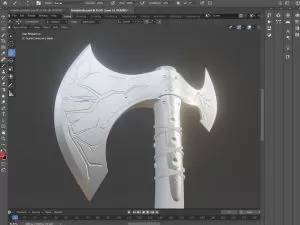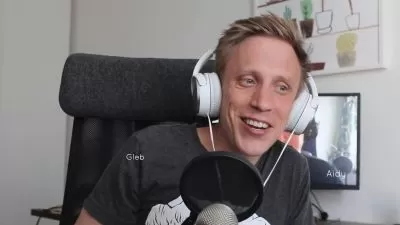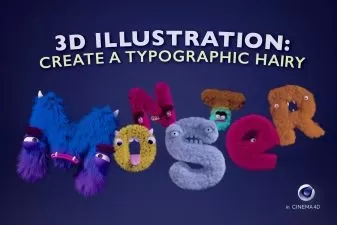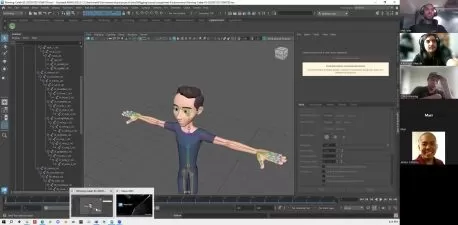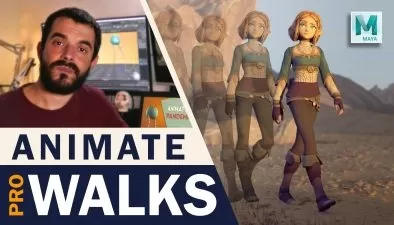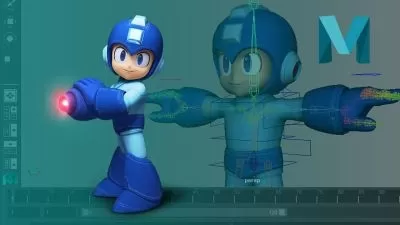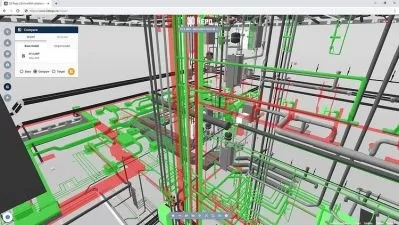3D Walk Cycle Animation using Autodesk Maya
Cristina Zoica Dumitru
4:05:27
Description
Learn how to animate a generic human walk cycle
What You'll Learn?
- How to animate a human walk cycle in 3D
- How to create a smooth and balanced walk cycle
- Maya Keyframe animation, from blocking to refining
- Maya framework using Timeline, Auto-keying, Ghosting, Graph Editor
- How to create and set a Maya Project
- How to reference a rig
- How to install and use a Ghosting Script
- How to create a mirrored and symetrical posture
- How to connect information between the real science of biomechanics and the animation workflow of a walk cycled posses of a walk cycle
Who is this for?
What You Need to Know?
More details
Description3D Walk Cycle Animation using Autodesk Maya is an intermediate 3D Animation course that teaches how to animate a human walk cycle.
The aim of the course is to showcase the animation pipeline of creating an organic and well-balanced 3D walk cycle. This workflow is the base for both 3D films and games.
Throughout the course, we'll build the mechanics of the walk cycle through several and progressive animation passes. You will develop a strong foundation on how to build the animation from blocking the first key contact posses, to cleaning the motion graphs, to adding the final body overlaps.
Understanding the mechanics behind real human locomotion is crucial for a walk animation. Therefore, this course offers an insight into human locomotion concepts in connection to the animation pipeline.
This course it’s an insight on how to bring that spark of life into a human character and once you follow this workflow you’ll be able to animate any human walk, with any type of rig because the secret is the same.
Teaching modules
The course is being divided into several sections covering all the necessary tools with a 100% real-time animation process and explanations. The workflow is a progressive where each animation pass is being saved as a new Maya scene.
The course modules are:
Introduction Lecture
Setting the Maya Project
Animation Pass 1. Heel Contact Postures
Animation Pass 2. Foot Pass Postures
Animation Pass 3. Squash Postures
Animation Pass 4. Stretch Postures
Animation Pass 5. Cleaning the Motion Graphs
Animation Pass 6. Arms Overlaps
Animation Pass 7. Head Overlaps
Animation Pass 8. Feet Grounding and Orientation
Animation Pass 9. Final Cycle and Good Bye
What you’ll learn in this course
A human walk cycle is known as a gait cycle where each walking step is being build up from 4 key poses: the heel contact, the squash pose, the passing pose and the stretch pose, after which we walk back into the the second step. This course is approaching all this in great detail.
As animators, we must use real world principles in order to capture the illusion of a believable motion. So the course starts with a short lecture on Animation Resources and Workflows but also a brief into the real science of Bio-mechanics for Human Locomotion.
Then, we gonna approach the animation task with a plan in how to address all the animation passes. This approach optimizes the process and creates clarity. Therefore, each animation pass or course section starts with a few minutes introduction around what we need to accomplish. And then, then will jump into action.
The working files
1 Maya project containing 10 different *.ma files, each file represents an animation pass, from blocking version to final version
1 JPG file as a walk cycle animation planning sheet
1 Ghosting Script, free resource
1 Character Maya rig with texture files, free resource
4 playblast Videos of the final Walk Animation (front, back, side, perspective views)
Specific animation tools and frameworks
Maya Project and File Referencing
Timeline, Auto-keying, Graph Editor
Creating a custom shelf with shortcuts and tools
Installing and using a Maya Ghosting Script
After this course
Remember, the walk cycle animation is an extremely knowledgeable process in learning character animation, with the right rig and the right application of animation principles this course gives you a very solid foundation for bio-mechanics animation.
Once you understand the mechanics and workflows of the generic human locomotion, you'll get a huge boost of confidence and skills. You’ll be able to create any type of walk cycle animation, any type of personally walk, using any type of human character.
Who this course is for:
- Intermediate users of Maya Animation
- 3D Animation and Game Design students
- Anyone with a desire to learn how to animate a walk cycle in Maya
- Anyone with a desire in learning character animation
3D Walk Cycle Animation using Autodesk Maya is an intermediate 3D Animation course that teaches how to animate a human walk cycle.
The aim of the course is to showcase the animation pipeline of creating an organic and well-balanced 3D walk cycle. This workflow is the base for both 3D films and games.
Throughout the course, we'll build the mechanics of the walk cycle through several and progressive animation passes. You will develop a strong foundation on how to build the animation from blocking the first key contact posses, to cleaning the motion graphs, to adding the final body overlaps.
Understanding the mechanics behind real human locomotion is crucial for a walk animation. Therefore, this course offers an insight into human locomotion concepts in connection to the animation pipeline.
This course it’s an insight on how to bring that spark of life into a human character and once you follow this workflow you’ll be able to animate any human walk, with any type of rig because the secret is the same.
Teaching modules
The course is being divided into several sections covering all the necessary tools with a 100% real-time animation process and explanations. The workflow is a progressive where each animation pass is being saved as a new Maya scene.
The course modules are:
Introduction Lecture
Setting the Maya Project
Animation Pass 1. Heel Contact Postures
Animation Pass 2. Foot Pass Postures
Animation Pass 3. Squash Postures
Animation Pass 4. Stretch Postures
Animation Pass 5. Cleaning the Motion Graphs
Animation Pass 6. Arms Overlaps
Animation Pass 7. Head Overlaps
Animation Pass 8. Feet Grounding and Orientation
Animation Pass 9. Final Cycle and Good Bye
What you’ll learn in this course
A human walk cycle is known as a gait cycle where each walking step is being build up from 4 key poses: the heel contact, the squash pose, the passing pose and the stretch pose, after which we walk back into the the second step. This course is approaching all this in great detail.
As animators, we must use real world principles in order to capture the illusion of a believable motion. So the course starts with a short lecture on Animation Resources and Workflows but also a brief into the real science of Bio-mechanics for Human Locomotion.
Then, we gonna approach the animation task with a plan in how to address all the animation passes. This approach optimizes the process and creates clarity. Therefore, each animation pass or course section starts with a few minutes introduction around what we need to accomplish. And then, then will jump into action.
The working files
1 Maya project containing 10 different *.ma files, each file represents an animation pass, from blocking version to final version
1 JPG file as a walk cycle animation planning sheet
1 Ghosting Script, free resource
1 Character Maya rig with texture files, free resource
4 playblast Videos of the final Walk Animation (front, back, side, perspective views)
Specific animation tools and frameworks
Maya Project and File Referencing
Timeline, Auto-keying, Graph Editor
Creating a custom shelf with shortcuts and tools
Installing and using a Maya Ghosting Script
After this course
Remember, the walk cycle animation is an extremely knowledgeable process in learning character animation, with the right rig and the right application of animation principles this course gives you a very solid foundation for bio-mechanics animation.
Once you understand the mechanics and workflows of the generic human locomotion, you'll get a huge boost of confidence and skills. You’ll be able to create any type of walk cycle animation, any type of personally walk, using any type of human character.
Who this course is for:
- Intermediate users of Maya Animation
- 3D Animation and Game Design students
- Anyone with a desire to learn how to animate a walk cycle in Maya
- Anyone with a desire in learning character animation
User Reviews
Rating
Cristina Zoica Dumitru
Instructor's Courses
Udemy
View courses Udemy- language english
- Training sessions 37
- duration 4:05:27
- English subtitles has
- Release Date 2023/09/11






